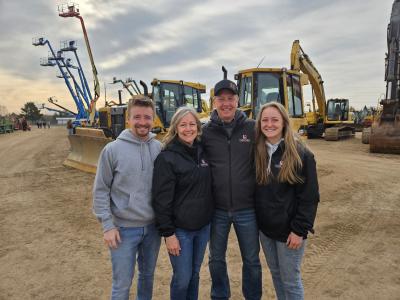Rain set off a rock slide at the 17-mi. marker on U.S. 64 in the Ocoee River Gorge in Polk County, Tenn., early one morning in November, blocking the west lane. The Tennessee Department of Transportation (TDOT) quickly dispatched mobile maintenance crews to clear it, but when a boulder the size of a truck fell on the east lane, TDOT brought in a private contractor to break it up with an impact hammer in preparation for removal.
A few hours later, TDOT geologist Vanessa Bateman arrived from her Nashville office. Upon hearing a thunderous cracking noise, she ordered workers to move back just before continuous rain precipitated another slide that dropped boulders on the roadway. In a matter of seconds, the scope of the cleanup had been magnified, with the road obliterated. News crews on the scene captured the spectacular slide on film. (http://www.wdef.com/work_crews_dodge_major_rock_slide_on_highway_64)
Enter, Stage Left
TDOT awarded a $2.1 million emergency repair contract to Sevierville, Tenn.-based Charles Blalock and Sons Inc. Work includes stabilization of the rock slope on Little Frog Mountain and removal of the estimated 30,000 cu. yds. (22,936 cu. m) of slide debris, or about 3,000 dump loads. Additional rock will be removed from the mountain in order to prevent potential future slides.
Work is expected to take eight weeks, but weather-related and logistical challenges could push that deadline. “Due to the nature of the work and the associated dangers, the precautions that are having to be taken due to the proximity of Tennessee Valley Authority Dam No. 2 and the cable anchor bridge over the dam, the completion date is our best estimate at this time. The contractor and TDOT are working closely with TVA and the Forestry Service to mitigate any potential danger while trying to maintain an aggressive schedule,” stated Jeff Sikes, supervisor of Tennessee operations for Thompson Engineering Inc.,
Rain has already delayed progress and as the seasons change, Sikes expressed concern about ice and freezing rain, as well as water leaching from the mountainside that will undergo freeze-thaw cycles with colder weather. The temperature in the Ocoee Gorge is, on average, lower than it is in nearby Chattanooga. “Rain makes the slope more dangerous and can set off slides. We put crews in harnesses, with a man controlling them. Spotters also keep watch whenever anyone is working on the slope,” Sikes said.
U.S. 64 is an important east-west corridor just east of Chattanooga. Its closure has rerouted traffic on a 100-mi. (160 km) detour, so TDOT is anxious to reopen it as soon as feasible. With the hope of meeting the Jan. 15 date, the contractor is planning to work seven days a week.
Before any material can be removed from the site, crews have to stabilize the slope. Before they can begin any work, however, they have to get equipment in place. “To get equipment from one side to the other is a 100-mile trip,” said Sikes, Because the two sides of the slide are cut off from one another, equipment is being placed on both sides. Getting it there poses a logistical challenge.
A 275-ton (249 t) Terex crawler crane with a 330-ft. (100.5 m) boom arrived in pieces on nine lowboys. Small cranes off-loaded and helped to assemble the big crane. An aggregate base pad for it was constructed on the west side of the project. Additional equipment is being trucked in, but because there’s nowhere on the two-lane road for the trucks to turn around, cranes are being used to lift them and reposition them pointing them in the opposite direction.
The 275-ton crawler crane will be used for scaling and drilling operations in preparation for large-scale trim blasting. In addition to the crane’s 12 by 20 ft. (3.6 by 6 m) platform the other equipment onsite includes a 100-ton (90.7 t) rubber tire Terex crane, a 35-ton (31.7 t) Grove crane, two-man baskets for each crane, an Atlas Copco Model C-30 drill, an Ingersoll Rand 490 hydraulic drill, a Cat 966 front-end loader, two Komatsu 300 trackhoes, a 60-ft. (18.2 m) Liftall all-terrain manlift, a 7,500-lb. (3,401 kg) ramhoe breaker for the trackhoe and two Ingersoll Rand air compressors (175 and 375).
Cleanup Sequence
Because the slide destabilized some areas, safety is the first concern. The media is not allowed onsite due to fears that the eastern side of the slope may come down. An inspector remains onsite, along with the state geologist or an assistant and state survey crews, all of whom will monitor the mountain for movement.
Work to be done includes scaling and trimming, trim blasting, pre-split blasting and rock removal. Rock bolts also will be placed to secure material adjacent to areas where rock was removed in order to forestall future slides.
The location of the work site and the logistics of moving in equipment require a well-communicated plan centered on a methodical sequence of events. “It’s not a simple demo and haul job,” Sikes confirms. Thompson Engineering was hired to provide oversight and inspect cleanup efforts. Often considered a “go-to” firm for emergency cleanup and repair, the company, with headquarters in Mobile, Ala., has maintained branch offices in Tennessee since 2002 and is increasingly selected for difficult, high-profile jobs. They are working closely with TDOT and Blalock on this project.
Working east from the west end of the project, crews first removed vegetation and debris from the upper reaches of the slide area in preparation for scaling and trimming operations. An 80-ton (72.5 t) hydraulic crane was used to pull some material to the base of the slope, where it is being loaded into dump trucks and hauled to one of three off-site dump locations. “We’re scaling to bring down loose boulders,” Sikes explains.
Large boulders near the top of Little Frog Mountain have shifted, causing Bateman to insist that clearing begin at the top before crews start on the road. It’s not safe to bring in equipment, she said, because clearing debris at the bottom could unbalance the material farther up and another slide could occur. Although a slide of this magnitude is unusual, the debris at the bottom could be supporting unstable rock further up, so disturbing it could trigger another big movement.
Getting Blasted
Sikes explains that there are three types of blasts planned for this project. What he calls spot blasting will bring down the large overhead outcroppings that are too big for hand tools. This is a safety measure that has to be performed first because some of these outcroppings hang above the work area. The boulders range in size from 3 ft. (0.9 m) to nearly 15 ft. (4.5 m) in diameter.
Next, Dyno Nobel Americas, based in Lexington, Ky, will drill holes down to the seam in the mountainside to conduct trim blasting. Unstable rock above the stable layer will be brought down in sheets in order to prevent future slides. Sikes expects ongoing blasting through at least two-thirds of the eight-week schedule. “We have to reach everything with a crane, move up, stabilize, move up… Blasting will be done on a weekly basis.” He adds that these are “very controlled” blasts, precisely placed to remove only what’s necessary.
Seismic sensors and three monitors are in place to measure existing cracks in the Ocoee Dam. Built in 1913, the timber crib hydroelectric diversion dam is on the National Historic Register. Although it still retains water, the TVA dam exhibits some cracks due to age. Sikes said crews are very conscious of the potential threat blasting poses to the dam and anchor bridge, so they measure cracks to the millimeter.
Not only is the dam a powerplant, but it also serves as the launching site for white water rafts. Damage to the rock shelf supporting the wooden trough that carries water or to the dam itself could result in ruining the site. “We recognize the need to lessen our footprint,” Sikes said. “We know we’re working in a pristine forest. We look at the geology of the rock to determine how deep to drill. We know we have only one chance to get it right.” Cherokee National Forest encompasses 640,000 acres (258,998 ha) in Tennessee.
The contractor hauled in approximately 200 tons (181.4 t) — 10 truckloads — of aggregate, which was spread across U.S. 64 on the east end of the work site in a 2- to 3-ft. (0.6 to 0.9 m) layer to act as an energy dissipater for falling rocks with the intention of absorbing energy and reducing travel distance of the falling material.
The contractor also installed erosion and sediment control measures to prevent runoff at the site. Little Frog Mountain consists of layers of soft rock in between layers of hard rock. Rain washes out soft rock and dirt, contributing to slides. The adjacent county recently experienced a 3.0 earthquake, which, along with heavy rain, helps make this area especially prone to slides.
Finally, additional blasts will be set off to break up large boulders so loaders and track hoes can pick them up and load them for removal. “Some boulders are the size of small houses,” Sikes exclaims. Hoe rams also will be used to help break up large boulders.
Anchors Aweigh
Forty-foot holes will be drilled into the mountain so that threaded bolts can be installed and grouted into place to allow the tension to “bolt down” the rock. “We want to stabilize the east side shelf above the dam because we’re concerned about another slide,” Sikes explains. The anchors are intended to secure material along the slope to avoid future slides.
Only after the slope has been stabilized through blasting and bolting will crews begin to remove debris from the roadway. Rock that was part of the slide will be used to repair the slope below the roadway and bring the embankment back up to subgrade elevation. Sikes explains that crews will cut out barrier wall debris and road damage to subgrade, reconnecting the barrier wall on the river side of the road and repairing the ramp if necessary. “We’ll do some work on the ramp and in the river while TDOT and the contractor work on the road.”
Despite the primary challenge of complicated logistics, Sikes remains optimistic about the job, citing good collaboration and communication as keys to making the job safe and keeping it moving forward. “We have an experienced blaster and a good contractor who has a lot of rock slide remediation experience. We’re happy to be selected for this project.”
Today's top stories















